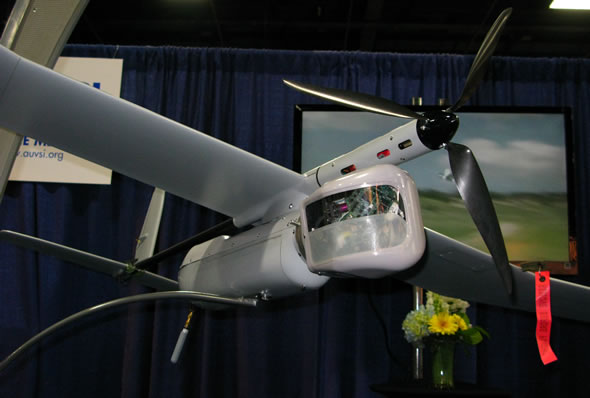
The U.S.-Israeli UAS Dynamics joint venture has taken the Skylark 1LE mini UAV to new levels, enhancing its performance, mission capabilities and operability to new levels. According to Peter Klein, UAS Chief Engineer at the company, assessing U.S. requirements made it clear that the needs of the U.S. forces and Special Operations community were different from those set by the Israelis, which necessitated significant enhancement of the already improved version of Skylark I.

“At the AUVSI 2010 we have asked Controp, the original payload manufacturer to come up with a multi-sensor payload for the Skylark, and today we are showing the M STAMP payload on our Skylark 1LE for the first time” Klein told Defense Update. The M STAMP is the largest member of Controp’s STAMP family of miniature EO payloads. It integrates two sensors – a daylight10x zoom TV and dual Filed of view uncooled thermal imager, coupled with a integral laser pointer, all packed into a 1.2 kg payload. The new EO payload offers high resolution and high stabilization, which coupled with the air vehicles high performance, enables the enhanced Skylark 1LE to loiter at higher elevation while maintaining sufficient image resolution for the warfighter. Higher operating altitude means better coverage, communications range and reduced interference which commonly limits the use of small UAS in mountainous areas such as in Afghanistan.
As part of the preparation of the Skylark 1LE for the U.S. user UAS Dynamics introduced a U.S. datalink, compatible with U.S. military communications standards and security levels. Skylark 1LE can now transmit video directly to U.S. forces using standard video terminals (Rover). According to Klein, UAS Dynamics plans to add more processors on board is also being increased, increasing processing power to support on-board computation of automatic tracking, change detection over a wide area and complex geo-location algorithms supporting advanced networked warfighter applications.
Another improvement introduced with the U.S. model of Skylark 1LE is the use of more powerful propulsion and efficient three-blade propeller, clearing the miniature aircraft for safe hand launch. Elbit recommends the use of bungee for launching its Skylark 1LE but according to Klein, U.S. operational requirements demand hand launching as an option. On board power is also being increased with the introduction of battery and fuel cell hybrid technology, currently being evaluated by the U.S. Air Force Research Laboratory (AFRL). The system employs a Protonex hydrogen fuel cell that keeps charging the lithium ion batteries throughout the mission, extending mission endurance by 100 percent, from three to six hours with full payload and enhanced avionics. The fuel-cell Skylark 1LE configuration was displayed at AFRL at the AUVSI 2011 exhibition.
















